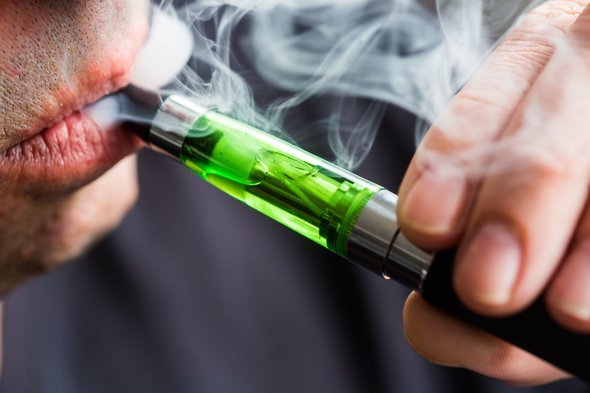Vitamin Vaping Raises Wariness among Scientists

You’ve still got to eat to live, but now you can purportedly back this up by vaping your vitamins.
One company claims a few puffs on their e-cigarette packs your lungs with 10 times the recommended daily dose of vitamin B12. Other products contain a cocktail of vitamins including A, C or D or other nutrients such as amino acids and collagen—all in a liquid that is vaporized on a heated metal coil, then inhaled.
Companies making these devices say they are designed for wellness, and that science guides their formulations to make them as healthy as possible. But scientists say the research the vaping industry uses to back such claims is not up to date, or is being presented out of context. “To me, [using vitamins and nutrients] is a marketing ploy to sell this product and make it look healthier. Consumers associate vitamins with health,” says Regan Bailey, a nutritional epidemiologist at Purdue University. “These products might be completely safe, but they might not be. We know literally nothing about the safety or efficacy of inhaling vitamins.”
Vaping vitamins is “theoretically possible,” says Guenther Hochhaus, a pharmacologist at the University of Florida who studies drug delivery in the lungs. “It would have to go deep into the lungs” where the membranes are thinnest and most permeable, he says. But until more detailed studies are completed, he adds, how well the lung actually does take in nutrients is up for debate.
The budding vape wellness industry itself seems divided over what is useful or safe when it comes to inhaling nutrients. “There are a lot of snake oil salesmen out there. We’re not a gimmick, and we’re here to help,” says George Michalopoulos, founder of VitaminVape. He says he created the company because vegans like himself often need an extra hit of vitamin B12. But he chose not to include collagen nor vitamin C or D over worries those nutrients could be unsafe to vape. “I would put vitamin D in because people are low in vitamin D—but it turns out that inhalation of vitamin D might be toxic,” he says. “We thought the only real science performed on what you can inhale was with B12.”
Other vitamin vape makers disagree. “We did want to use B vitamins but we veered away from them,” says Avi Kwitel, co-founder and CEO of Sparq, a company developing a product called Vitamin Air. “There were reports that came out that high amounts of B12—taken orally—were causing lung cancer in males.” (The study he was referring to, carried out at The Ohio State University, showed a correlation between men who took B12 and B6 supplements and higher cancer rates). Instead, Kwitel says their company chose to include vitamin D in their formula because of a 2016 study in which University of California, Los Angeles, researchers had baby rats inhale vitamin D. The study showed “how inhaling vitamin D is a potentially promising and safe strategy to consider,” he says.
But Virender Rehan—the University of California, Los Angeles, neonatologist who conducted that research—balks at this interpretation. “I’m really shocked that somebody would accept that study to claim that vitamins can be inhaled to improve health, particularly in adults,” he says. Vitamin D deficiencies can lead to lung development problems in newborns, and the study was partly to see if inhaling vitamin D could fix that problem in rats, he says. “But [it was] also to make sure that not much vitamin is absorbed [into the bloodstream],” he adds. Too much vitamin D can be toxic, especially for newborns.
Furthermore, the science Michalopoulos refers to about inhaling vitamin B12 was mostly performed in the 1950s and ‘60s. And most of these studies used nebulizers—machines that distribute medicine in a cool mist, not e-cigarette devices that heat solutions on a metal coil. In order to assert safety or efficacy, Purdue’s Bailey says more up-to-date studies are needed. “We’ve revolutionized our science since the ‘50s and ‘60s,” she says. “So at the bare minimum, I would like to see some safety testing done on these products.”
Like Bailey, Rehan and Hochhaus are skeptical about the potential health benefits these products might hold, and warn nutrient vaping might have unforeseen risks. “For example, vitamin C is an acid,” Hochhaus says, questioning the effect inhaling an acid might have on one’s lungs.
There may be unknown risks to nutrient vaping, Sparq’s Kwitel says—but adds his company is simply trying to create a better option for consumers who already vape or smoke. “We know [some vape ingredients] on the market are not healthy and we decided to stay away from that,” he says, referring to other nutrient vapes as well as nicotine-containing e-cigarettes. “We want to provide a non-harmful alternative to people already vaping.” He compares Sparq’s products with reduced-fat junk food. “Are half-fat potato chips 100 percent healthy for you? No. Is it much better than the alternative? Absolutely.”
Kwitel says his company has taken great pains to ensure its product will not cause harm. He and his colleagues sent their products to a third-party chemical testing lab to check if vitamins and other ingredients were being destroyed or transformed into harmful compounds from the heating and vaporization. “There’s a lot of stuff that didn’t work,” he says. “We put a tremendous amount of time and money into this.”
Even if vitamin vaping is safe and effective, why anyone would start this new habit is baffling to some. Healthy adults get their vitamins and amino acids just fine from eating, Hochhaus says. “So I don’t see any reason why you should inhale it.”
Hi! I am a robot. I just upvoted you! I found similar content that readers might be interested in:
https://www.scientificamerican.com/article/vitamin-vaping-raises-wariness-among-scientists/